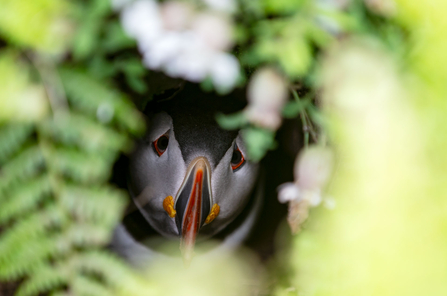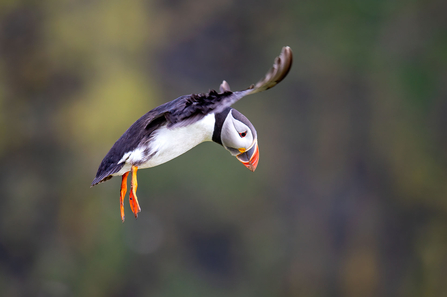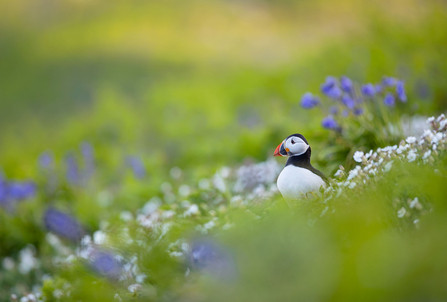It’s always important when photographing wild animals to avoid disturbing them or damaging their environment. On Skomer this means sticking to paths to avoid collapsing seabird burrows and not blocking puffins from returning their burrows.
Brian’s Top Tips for Puffin Photography- A Nature Photographer's Perspective of Skomer
© Brian Matthews
Explore the island
Skomer has lots of puffins and lots of places to see them (you don’t just need to head to the wick). Always have a look around; the key to success is getting something different. Once you’ve found a good spot, get comfortable and low (stay on the path and avoid blocking it). Observe your selected puffin for a few minutes to understand its behaviour, then position yourself behind the lens. Pay attention to your foreground and background—clear foregrounds typically work best with a low angle. Watch out for distractions in the background, such as other puffins, long grass, or rocks. Wait for the puffin to engage in something exciting and capture the shot!

© Brian Matthews
Practice makes perfect
If you pick a puffin, you’ll notice that they will circle or wheel around the area several times before landing allowing you to get flybys. Practice first with a shorter lens, 200mm then build it up, before you know it, you’ll be getting sharp flying head shots from your 800mm. Try slowing the shutter down to less than 1/100s to grab a panned (aka blurred but maybe sharp enough) shot!

© Brian Matthews
Make the most of natural light
Backlight their amazing beaks. If you position the sun right behind the puffin's beak, it'll shine right through and make it glow. You'll need to plan your shot carefully, considering the movement of the sun. Ideally, it'll be low in the sky (sunset or sunrise) and you'll need a cooperative puffin. Watch your exposure settings; underexpose (up to 3 stops) and find a balance between capturing a silhouette and making that beak light up!

© Brian Matthews
Capture their environment
It can be challenging to capture a wider-angle shot of wildlife; it may appear cluttered, and controlling all elements is tricky. While out in the field, you may be tempted to focus on close-up shots of puffins with Sand eels in their mouths. However, to achieve a shot like 'Puffin Meadow', the print you can purchase to support The Wildlife Trust of South & West Wales, you need to capture the puffins small in the frame, surrounded by flowers and grass. Get low to control the foreground, frame it carefully, wait for the puffin to face the way you want it or even move into the spot you'd like. It probably won't, but with enough tries, it might just happen.

© Brian Matthews
Brian is selling a limited edition Puffin print to raise up to £10,000 to support seabirds of Skomer Island. You can use code bwmphoto20 for 20% off - this discount is limited to the first 50 prints. Purchase a print on Brian's website.
